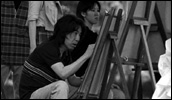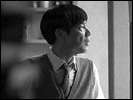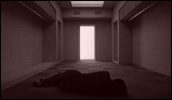Tony Takitani
- Year
- 2004
- Original title
- Toni Takitani
- Japanese title
- トニー滝谷
- Director
- Cast
- Running time
- 75 minutes
- Published
- 21 October 2007



by Dean Bowman
Jun Ichikawa's film version of one of Haruki Murakami's most elegant short stories, Tony Takitani, somehow manages to redefine the whole process of literary adaptation, though with the same quiet, unassuming grace of the original story. Ichikawa visualises this character study of loneliness as a series of vignettes, ending each scene with a lateral wipe from right to left (except for the occasional and effective use of a fade to black), like the turning of a page.
This radical device serves to foreground the film's literary source just as it finds a cinematic equivalent for it, something that can indeed be said of the film as a whole, which follows the source word-for-word, yet replaces each word with an image. Of course the overtly literary voice of the narrator remains, imparting Murakami's prose with its characteristic intermixing of the prosaic and the poetic, yet he is constantly cut out by the characters, who finish his sentences or take over completely. This gentle tug-of-war between the narrator and his objects not only serves to further isolate them, but also emotionally distances the viewer. In a sense we are being forced to not only sympathise with Tony's lonely world-view, but to actually adopt it in the process of watching the film. It's a risky strategy that some will find moving and many more will find frustrating, yet it is precisely this uncompromising aesthetic that makes the film such an artistic success.
As in the story, Tony's life is given as a mere fleeting outline, through which he wanders with the passivity of a somnambulist, perfectly rendered by veteran actor Issey Ogata, who brought a similar sense of nuanced normality to his portrayal of Emperor Hirohito in Aleksandr Sokurov's The Sun (Solntse, 2005). The loneliness that marks Tony's life starts in his childhood with the death of his mother and the absence of his father, and continues through his school days where his very name isolates him, embodying as it does at the time Japan's capitulation to America. Tony takes comfort in his singular ability to draw with incredible accuracy, a talent that seemingly compensates for the lack of control he has over his own life. Tony's drawings are so formal that they alienate him from his peers at university, who engage in the ideological and abstract art characteristic of the rebellious sixties. Incidentally the sixties are a decade that Murakami deals with in the form of an allegorical, unrequited love story in A Folklore for My Generation: A Prehistory of Late-stage Capitalism, in which a man, given the opportunity to make love to an ex-girlfriend years after they part company still virgins, realises that he can never return to a state of innocence. Few writers can conjure up such a devastating sense of nostalgia peculiarly stripped of sentimentality, and Ichikawa manages to capture a similarly rarefied atmosphere in his elliptical approach to cinematic time.
Tony's drawings guarantee him a career as an illustrator, where he finally meets and marries a woman named Eiko Konuma, whose obsession with clothes fills a gap inside her in a similar manner to Tony's drawing. She accumulates clothes with alarming speed, so that Tony has to convert a room in their sterile modern apartment into a walk-in wardrobe, then dies abruptly in a car-crash, leaving Tony alone 'with a room full of size 7 dresses and 112 pairs of shoes' - the lingering shadows of her life that eventually disappear along with his memories. The way the camera caresses the rows of dresses, each one slipping into focus for just a brief second as the camera passes over the fabric, very strikingly captures this aspect of the book. When the film ends we realise that in the mere space of 70 minutes (and the brevity of the piece is here perfectly suited to the overall emotional effect) we have watched a man's life unfold from birth to old age, utterly poignant in its banality.
Ichikawa makes two main additions to Murakami's sparse narrative of lost moments (a kind of stripped-down Proust). The first is a scene in which Tony, now a widower, attends a drinks reception and is approached by Konuma's former lover, who declares inconsiderately 'that chick was a real pain' and then insultingly says of Tony 'you are dull after all, just like your paintings'. This only goes to demonstrate that Ichikawa's depiction of the titular protagonist shows him to be even more of a pathetic, passive figure than he is in the story, perhaps more like Meursault in Camus' The Outsider. This may be Ichikawa's only fault, because whilst Murakami's story emphasises the ordinariness of Tony's character, the film marks it as exceptional. Murakami's story is a study of the essential loneliness of life, whilst Ichikawa's film is a study of the essential loneliness of a life.
The second and most significant addition is Ichikawa's choice to cast the same actress, Rie Miyazawa, in both the role of Tony's wife and Hisako, the girl he briefly employs as his secretary in an attempt to replace her. By making Hisako, who is merely described as having 'an unremarkable face' in the book, Eiko's doppelganger in this way Ichikawa draws on an age-old cinematic convention most famously used in Hitchcock's Vertigo (1958), in which Jimmy Stewart gets a second chance after his dead lover, a San Francisco sophisticate, is seemingly resurrected in the figure of a bawdy shop-girl. Hitchcock's shadow has loomed large over Asian cinema in recent years, with many films making use of this game of dual identities, including Chinese director Lou Ye's exceptional experimental work Suzhou River (Suzhou He, 2000), and Pen-ek Ratanaruang's Last Life in the Universe (Ruang rak noi nid mahasan, 2003), a Thai/Hong-Kong/Japanese co-production starring Tadanobu Asano. In a particularly neat use of repetition Ichikawa uses the same shot of Rie running over the crest of the hill towards us, but this time with Hisako in place of Eiko.
However, just as Murakami's delicately understated story carefully sidesteps drama, Tony decides against employing her, and thereby cuts off the possibility of the Vertigo narrative as soon as it appears. This clever building and avoidance of audience expectation, which seems somehow more daring in the more market dependent medium of film, is perfectly suited to the story's themes of loss and absence. These themes are also expressed to great effect in the films steely, symmetrical cinematography, which echo Tony's own overly-lifelike yet essentially lifeless drawings, and Ryuichi Sakamoto's sparse, impressionistic piano score.
In short Murakami's story provides perfect material for Ichikawa, whose previous films include Dying in a Hospital (Byoin de Shinu to iu Koto, 1993), a moving film about terminally ill patients and the unattainable beauties of the world they will leave behind. His biggest success here lies in his ability to marry the novelist's words with cinematic counterparts, thus making something that is both familiar and different. This may be the ultimate aim of all adaptations, though it is something that is rarely achieved. Any scene could be taken from the film to illustrate this, but the most effective, I think, is the death of Tony's mother. In the story Murakami describes this with heartrending simplicity: 'and just like that she was cremated, all quick and quiet. She experienced no great complications and no suffering to speak of. She just faded into nothingness, as if someone had gone backstage and flicked a switch.' In the film Ichikawa shows her wandering into a grove of trees, dressed in an old-fashioned kimono and looking back smilingly at the camera, her impermanence alluded to by a few subtle jump cuts and focus-pulls. The images used just as elegantly and sparingly as the words.